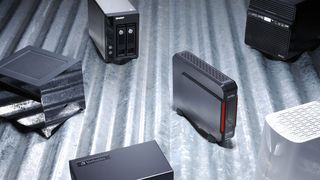Broadcom: content caching is key to the connected home
99.98 per cent of internet traffic crosses a Broadcom chip

There will be a hierarchy of data in connected homes, will relevant content popping up where – and when – you want it.
That's according to Broadcom's software director James Chapman who says that devices will become more intelligent to help – citing the development in System-on-Chip (SoC) architectures mean several layers of caching to help provide content where it's needed. According to Chapman, 99.98 per cent of internet traffic crosses a Broadcom chip.
He was speaking at this week's Future World Symposium, taking place at Wembley Stadium.
"You do need your content close to where you're playing it but you don't necessarily know which device that is before you do it," Chapman stated. "Google, Microsoft and Amazon are all trying to be very dominant in this area. It's moving from an ownership model to licensing [content] with services like Spotify."
"The connected home is actually the internet connected home because they often connect to things outside of their home. There will be a hierarchy of data within the home.
"But I think devices will connect to each other more in future. The question is where does the data live within the connected home and how does the data get in and out?
"There are other things going on, one of which is Wi-Fi Direct and a new standard called Wi-Fi Display and that's going to enable you to take content from a tablet and, like Wireless HDMI, push it to a TV."
Are you a pro? Subscribe to our newsletter
Sign up to the TechRadar Pro newsletter to get all the top news, opinion, features and guidance your business needs to succeed!
Low latency is a must
Chapman thinks fast caching of data is the key: "you care about when you don't have the data where you wanted it. We're going to have to have high bandwidth data connections with low latency" he added, talking about the next-generation 802.11c Wi-Fi which promises transfer rates of 3.6Gbps. "Video is driving it, that's over a thousand times increase in 15 years."
"The latencies involved make it difficult. There's a lot of work to do to keep the data rate up and latency down. Things like NFC are also going to be important for the connected home, so if I'm walking around with my tablet – how do I know what I'm trying to pair it with?" Chapman talked of the concept of physically pushing a device towards the TV so it "knows that's what I want to stream to."
"I don't know where the boundaries are for laptops and home computers, but they'll go wider. Look at that platform, powerful, highly capable and cost optimised. What that gives you is almost like a second revolution.
"What we're now seeing is hardware platforms giving us devices that can share content across multiple devices, beyond the phone. There's going to be huge competition. There are very few silicon manufacturers who can provide all that silicon.
"Which of those providers gets to own your home [over the next five years]; I think we're entering the post PC era."
Dan (Twitter, Google+) is TechRadar's Former Deputy Editor and is now in charge at our sister site T3.com. Covering all things computing, internet and mobile he's a seasoned regular at major tech shows such as CES, IFA and Mobile World Congress. Dan has also been a tech expert for many outlets including BBC Radio 4, 5Live and the World Service, The Sun and ITV News.
